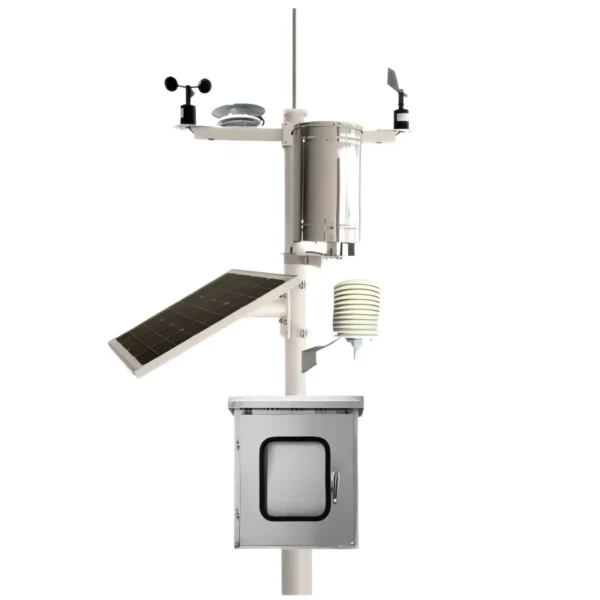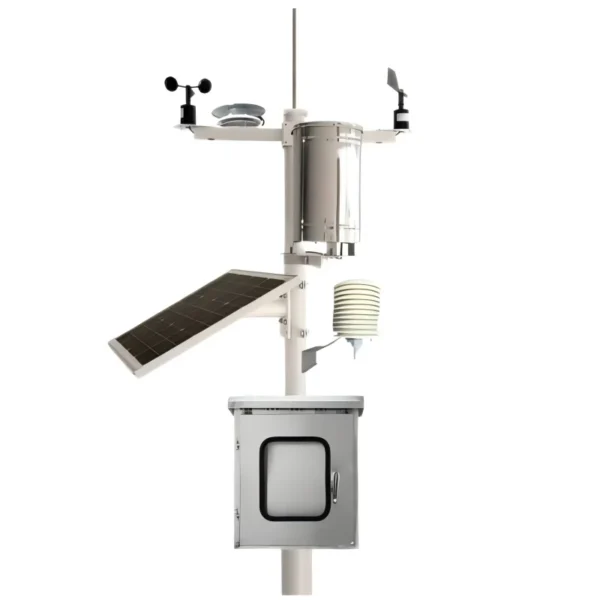
# Automatic Weather Station: A Comprehensive Overview
## Introduction to Automatic Weather Stations
An Automatic Weather Station (AWS) is a sophisticated system designed to collect and record meteorological data without the need for human intervention. These stations are equipped with various sensors that measure parameters such as temperature, humidity, wind speed, wind direction, rainfall, and atmospheric pressure. The data collected by AWS is crucial for weather forecasting, climate research, and various industrial applications.
## Components of an Automatic Weather Station
An AWS typically consists of several key components:
– **Sensors**: These are the primary data collection tools. Common sensors include thermometers for temperature, hygrometers for humidity, anemometers for wind speed, wind vanes for wind direction, rain gauges for precipitation, and barometers for atmospheric pressure.
– **Data Logger**: This device records the data collected by the sensors. It can store data locally or transmit it to a remote server in real-time.
– **Power Supply**: AWS units are often powered by solar panels, batteries, or a combination of both to ensure continuous operation.
– **Communication System**: This system transmits the collected data to a central database or a remote server. Common communication methods include GSM, satellite, and radio frequency.
## Applications of Automatic Weather Stations
AWS systems are used in a variety of fields:
– **Meteorology**: AWS provides real-time data that is essential for accurate weather forecasting and climate modeling.
– **Agriculture**: Farmers use AWS data to make informed decisions about irrigation, planting, and harvesting.
– **Aviation**: Airports rely on AWS for up-to-date weather information to ensure safe takeoffs and landings.
– **Environmental Monitoring**: AWS helps in tracking environmental changes and assessing the impact of human activities on the climate.
## Advantages of Automatic Weather Stations
The use of AWS offers several benefits:
– **Accuracy**: Automated systems reduce human error, providing more reliable data.
– **Efficiency**: AWS can operate continuously, collecting data 24/7 without the need for manual intervention.
– **Cost-Effectiveness**: Over time, AWS can be more economical than manual weather stations due to reduced labor costs.
– **Remote Monitoring**: Data can be accessed from anywhere, making it easier to monitor weather conditions in remote or inaccessible areas.
## Challenges and Considerations
While AWS systems are highly beneficial, there are some challenges to consider:
– **Maintenance**: Sensors and other components require regular maintenance to ensure accurate data collection.
– **Data Security**: Transmitting data over networks can pose security risks, necessitating robust encryption and security measures.
– **Initial Investment**: The upfront cost of setting up an AWS can be high, though it is often offset by long-term savings.
## Conclusion
Automatic Weather Stations have revolutionized the way we collect and analyze meteorological data. With their ability to provide accurate, real-time information, AWS systems are indispensable tools in various industries. As technology continues to advance, we can expect even more sophisticated and efficient AWS solutions in the future.
Keyword: automatic weather station
